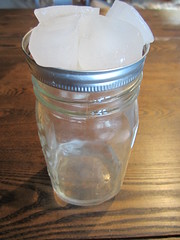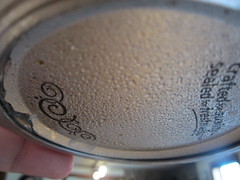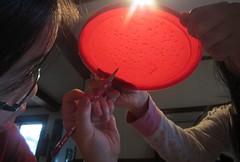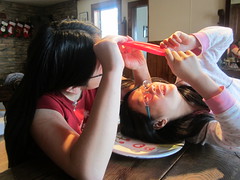Drops
Purpose: To determine how raindrops form.
Procedure: We poured some water into a quart canning jar - not a lot, just enough to cover the bottom of the jar. We turned the lid and band upside down and set it over the mouth of the jar; and then put four ice cubes inside the lid.
Jar with ice cubes on the lid
for the condensation/rain experiment.
The lid looked wet and finally some water drops formed on the underside of the lid. This was because some of the liquid water in the bottom of the jar evaporated (or changed into a gas).
Condensation formed on the lid.
This represents rain droplets. Eventually, the larger ones
fell into the water at the bottom of the jar.
This, then, continued the water cycle.
According to Earth Science, "The water vapor condenses and then changes back to a liquid when it hits the coool underside of the lid. As the amount of liquid increase, drops form on the underside of the lid.
"In nature, liquid water evaporates from open water areas such as streams, lakes, and oceans. This vapor rises and condenses as it hits the cooler upper air.
"Clouds are made of tiny drops of liquid water suspended in the air. Water drops in clouds range in size from .000079 to .0039 inches in diameter.
"The tiny water drops join together, forming larger, heavier drops. The drops start falling as rain when air can no longer support them. Falling raindrops range in size from .24 to .79 inches."
Bigger
Purpose: To determine how tiny water droplets in clouds grow into raindrops.
Procedure: We didn't have an eye dropper, so the girls used the ends of their hair dipped in water to sprinkle droplets of water on the coffee can lid. They put as many separate drops of water as they could on the lid.
Making do with what they had on hand
to create water droplets on the lid.
When they were done, they quickly turned the lid over. Sophia used a point of a pencil to move the tiny drops of water together.
Sophia using a pencil tip to join droplets of water together.
The larger drops fell to the plate below.
The drops do this, according to Earth Science, because "water molecules have an attraction for each other. This attraction is due to the fct that each molecule has a positive and negative side.
Olivia wanted to get a better view...
either that or she missed the feeling of rain.






1 comment:
What a fun and informative class for the girls! :)
Post a Comment